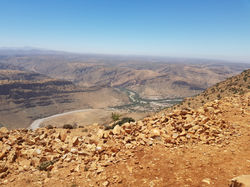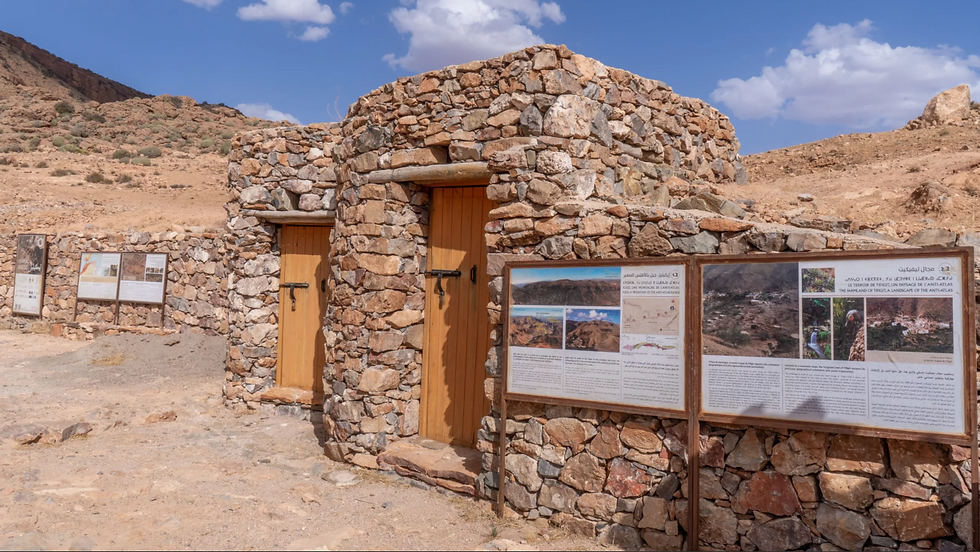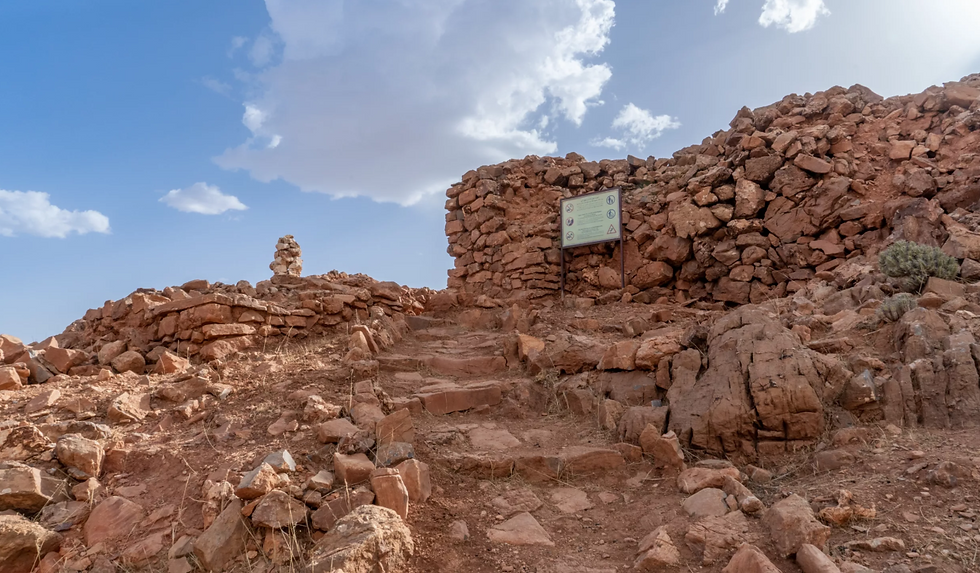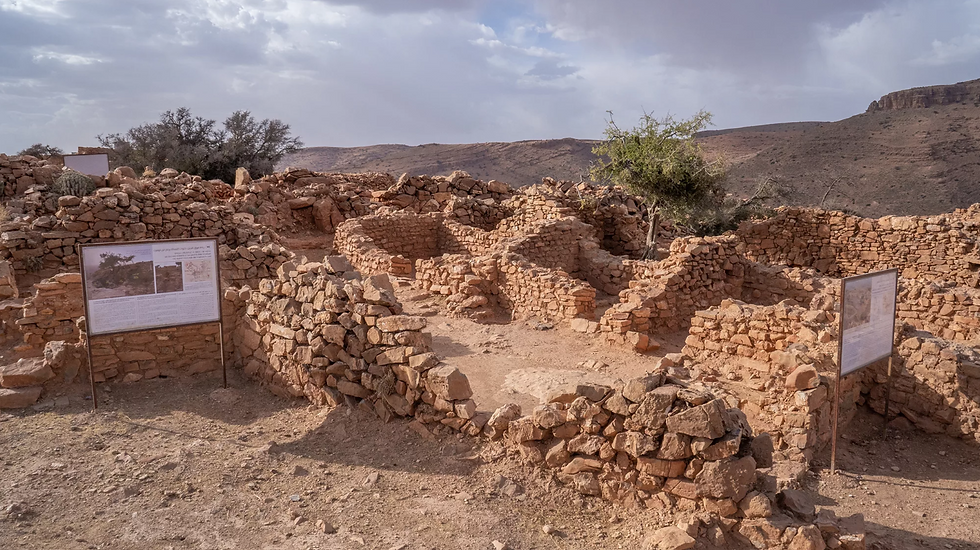Le Jardin aux Etoiles
Riad between Agadir and Taroudant, in southern Morocco
Holiday rental with a resident of Swiss nationality
 Igîlîz, an unbeatable siteThe Anti-Atlas as far as the eye can see. |  At the top of the rocky outcropA configuration designed to protect against attackers. |  Archaeologist at workEvery year, the site reveals new secrets. |  Archaeological workAn annual campaign is carried out in April, when the heat is not too oppressive. |  Découvertes récentesLa forteresse comprenait une mosquée principale et une résidence seigneuriale |  L'Empire almohade partit d'IgîlîzIl s'étendit durant plus d'un siècle à l'Afrique du Nord mais aussi à El Andalous, l'Espagne et une partie du Portugal actuels. |
|---|
Igîlîz: a little-known and fascinating archaeological site
Very recently discovered, the archaeological site of Igîlîz is of exceptional interest. In the early 1120s, the fortress of Igîlîz was the starting point of a religious revolution that would culminate in the founding of the Almohad Empire, the most powerful empire known to the Muslim West during medieval times. These ruins, the trace of which was lost for a long time, are perched on a spur intended to resist attackers and from where one enjoys a breathtaking view of the surrounding valleys and mountains. They are about sixty kilometers from Taroudant. It can be reached in two hours from the Jardin aux Etoiles.
Many historians thought that the origin of the Almohads was in Tinmel, a city created beyond the Tizi n'Test, a hundred kilometers from Marrakech by Ibn Tumert (also spelled Ibn Tumart), founder of the Almohad Empire. All that remains of Tinmel today are the ruins of a mosque destroyed by the earthquake of September 2023.
Igîlîz becomes a fortress
In reality, Ibn Tumart, born in a douar near Igîlîz, took refuge in this landlocked stronghold of the Arghen tribe when the Almoravids drove him out of Marrakech. He then claimed to be "impeccable imam" and professed a rigorous morality condemning any distraction including music.
Ibn Toumert knew the impregnability of this spur. He made it a fortress. From approximately 1120 to 1124, during his first sermons, he gathered around him the surrounding Berber tribes, peasants, devotees and warriors. He won his first confrontations against the Almoravids. Shortly after, he decided to set up his headquarters in Tinmel.
Discovered in 2004
Ibn Toumert's initial career and the genesis of the Almohad Empire have only been understood recently. Historians were looking for the location of this long-forgotten fortress, but could not locate it until, in 2004, a French-Moroccan archaeological mission managed to get their hands on it. This mission was led by Abdallah Fili, from the University of El Jadida, and Jean-Pierre Van Staëvel, from the Paris-Sorbonne University, as well as Ahmed Ettahiri from the National Institute of Archeology and Heritage Sciences. The trio relied on medieval written Arabic sources and the works of their predecessors.
In 2015, the mission received, with great fanfare, the Archeology Prize from the Simone and Cino Del Duca Foundation. In November 2022, the Igîlîz site was classified as a historical monument. Developments and enhancements must therefore be submitted to the Ministry of Culture in order to receive authorisation.

Igîlîz lives again !

Panoramic view of the Anti-Atlas.

Skilled workers from the region under the supervision of archaeologists.

The walls were rebuilt as soon as scientists were able to understand with certainty what the structure of Igîlîz had been.

Probably built for Ibn Tumert.

Ici une future archéologue stagiaire.

Selon les archéologues travaillant sur place, elle daterait de l'époque d'Ibn Tumert

Découverte il y a quelques années seulement

Ils témoignent d'un artisanat très sûr

Un témoignage précieux provenant d'une cuisine

Fondateur de l'Empire almohade, il ne vit toutefois pas la conquête de Marrakech ni l'extension de l'empire.

Le quartier général des Almohode fut déplacé d'Igîlîz à cet endroit, situé à une centaine de kilomètres de Marrakech
A large stately home
Archaeological excavations carried out each year have so far uncovered a large noble residence composed in particular of rooms grouped around a courtyard, which could have been intended for Ibn Toumert. A fairly modest mosque was cleared. Triangular, it faces due south, as was the case in the early days of Islam. Igîlîz included two other smaller mosques.
Places of teaching and preaching have also been identified. We found traces of furniture, bread ovens, as well as metal tools and thousands of ceramic pieces that allow us to better understand the rural civilization that populated Igîlîz. The archaeologists have also brought to light a better understanding of the site's military system, in particular the fortifications.
The mountain of Igîlîz conceals an unknown part of the advent of Almohads, who eventually conquered North Africa as far as Libya, as well as El Andalous, a large part of present-day Spain. Disappeared around 1130, Ibn Toumert did not experience this glorious expansion. The Almohad Empire weakened from 1212. In 1269, it was eliminated by the Merinids.
Indeed, the setting up of a tour circuit and the installation of reception facilities for tourists are very light facilities which facilitate the enhancement of the site without negatively influencing the main curiosity on site”, he adds. “We fitted out with local stone, using the same local products and the same colors. Besides, it is not visible, there is no visual pollution, everything is well integrated into the landscape”, specifies Mr. Azenfar.
The SDR led the development of a car park, toilets and rest stops to make the visit to Igiliz more pleasant. She also ensured the implementation of interpretive devices throughout the tourist circuit of Igiliz, the content of which was entirely developed by the two archaeologists mentioned above.

En cas de doute, vérifier auprès d'un autochtone si vous êtes sur le bon chemin !

Des paysages aussi sauvages que magnifiques.

Un chemin malaisé, mais on y arrive !

A pied depuis le village de Tifigit

Paysages superbes en contre-bas du sentier.

Vue plongeante sur le village de Tifigit

Un effort qui en vaut la peine...

Au cas où la montée paraîtrait trop difficile à certains.

Situé à Souk Larbaa Magnoun, dans la commune de Toughmart, il est le seul de la région. Vérifier avant de s'y rendre s'il est bien ouvert.

Panneaux explicatifs.

Les panneaux aident à comprendre.

Toujours de l'information !
A seriously uphill path
To visit Igîlîz, a good car is necessary. We leave Route 109 on the left, as shown our Google map below, to enter the domain of the Arghen tribe. This last name is also that of the wadi (assif in Berber) which dug the valley.
The roadway turns and crosses magnificent wild landscapes. We arrive at Souk Larbaa Magnoun, which is part of the rural commune of Toughmart (also spelled Toughmert). From Souk Larbaa Magnoun, you have to go around the djebel of Igîlîz, which requires asking the way to a passerby, who will gladly tell you. The road becomes a track, sometimes somewhat steep. But the Souss Massa Regional Tourism Development Company (SDR) has partly tarred this sector. Working in close collaboration with the archaeologists Abdallah Fili and Jean-Pierre Van Staëvel, already mentioned,
A little below the village of Tifigit, you leave your car in a parking lot, in order to make the ascent on foot. This is the only access to Igîlîz. Toilets have also been installed. The trail climbs seriously. You have to adapt your pace to your possibilities. Stops have however been set up, so that visitors can rest if they feel the need. It is also possible to hire a donkey if you don't feel up to it.
At the top, the reward is there: walls reconstituted with the seriousness of archaeologists who first wanted to understand how the site was structured before undertaking work that could have turned out to be premature or counterproductive. Throughout the tourist circuit set up, interpretation devices have been installed.
A path explanatory via an application
A site enhancement program is underway. “We have started discussions with the various actors from the Ministry of Culture, the municipality of Toughmart and the province of Taroudant to be able to promote the site. The Cultural Heritage Department has built a House of Archeology on site. This makes it possible to perpetuate archaeological research and above all to promote the work already carried out at the local level”, specifies Abdellah Fili. This House of Archeology is made available exclusively to archaeologists. She does not visit.
The development of the site will probably take the form, at the top, of an explanatory path, which can be followed via an application.
If the discovery day is prolonged, Talbourine mountain lodge can be life-saving (call Farid Tayeb +212 662 786 277). It is located inside the town of Souk Larbaa Magnoun (arriving from Taroudant, take the road to Toughmart, after crossing the bridge). Please note: the gîte was closed when we visited, in April 2019! It is therefore strongly recommended to ensure that it is open and, failing that, to return to the Souss plain at nightfall at the latest.
Photo credit: Mission archaeological site of Igîlîz and Pluri-Médias



